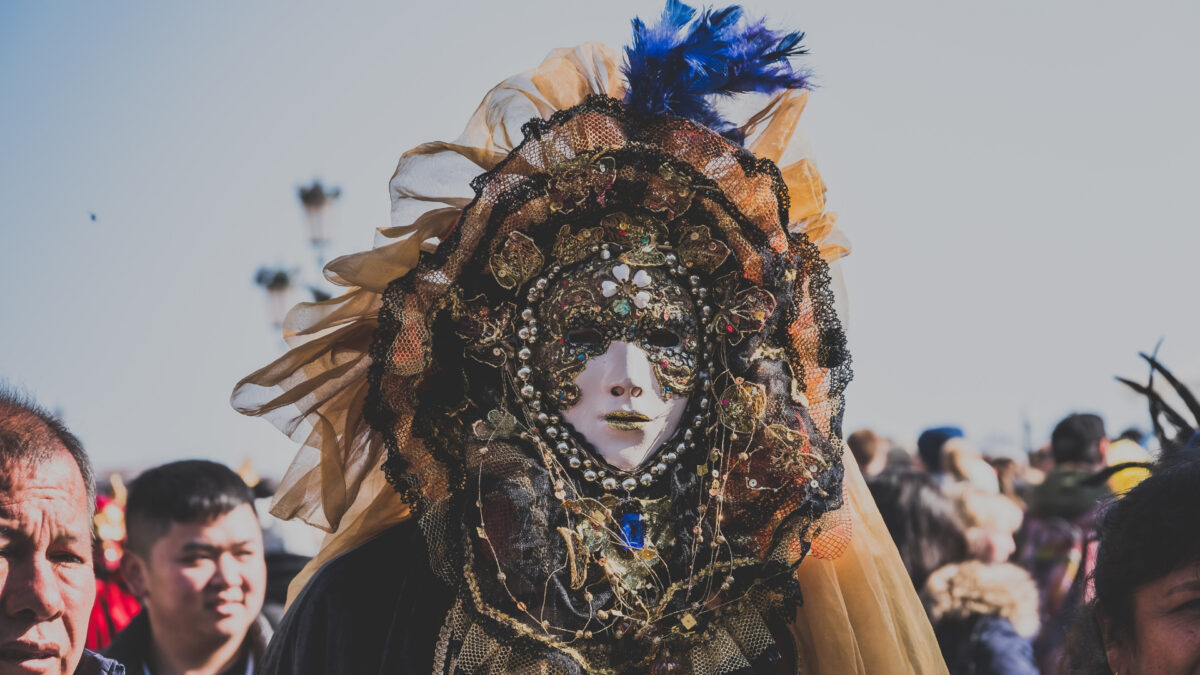
Exploring the Carnival of Venice: a timeless fusion of tradition and spectacle
The Carnival of Venice, Carnevale di Venezia, is not only Italy’s most popular Carnival but also a globally renowned event. Thousands of international visitors, adorned with an array of masks and costumes, converge in Venice every year to partake in this spectacle.
However, the colourful festival is more than just a gathering; it has a rich, complex history and has undergone significant transformations over the years. Let’s delve deeper into the intriguing tale behind the Carnival of Venice and uncover its evolution over the centuries.
What is the Carnevale di Venezia and its historical significance?
The Carnevale di Venezia, or the Carnival of Venice, is a captivating spectacle held annually in Venice, Italy. The term “Carnival” is derived from the Latin phrase “carnem levare“, which translates to “to remove meat.” This is about the period of Lent that follows, a time when Roman Catholics traditionally abstain from consuming meat.
The roots of the Carnevale di Venezia can be traced back to ancient Roman times. It was during this period that a festival saw the usual strict social hierarchy overturned. People from all walks of life would come together to partake in feasting, play games, and jest about usually taboo topics such as sex and religion.
Over time, the Carnival evolved to become a grand display of Venice’s cultural and artistic traditions. Masks and costumes became central elements, with people hiding their identities and social status, which allowed for greater freedom and transgression of the social order. The event is a fascinating blend of the sacred and the profane, with the religious observances of Lent on one side and the revelry and indulgence of the Carnival on the other.
When was the first recorded Carnival of Venice?
The first recorded instance of the Carnival of Venice, as recognized in official documents, dates back to a 1262 edict from the Senate of the Republic of Venice. This edict declared the Venice Carnival as a public holiday. However, traces of the Carnival’s rich tradition predate this document. Venetian artisans had been meticulously crafting their iconic Carnival masks for at least 20 years before this official recognition. The Carnival of Venice ascended to its zenith in the 18th century, drawing people from across Europe to partake in its vibrant festivities.
How is the Carnival of Venice celebrated?
The Carnival of Venice is celebrated with a spirit of jubilation, merriment, and a touch of transgression, staying true to its historical roots. The celebration revolves around the artful tradition of masquerading, which is the festival’s most distinctive feature.
During the Carnival of Venice, the entire city of Venice, where the Carnival is celebrated, metamorphoses into a dazzling stage set for an elaborate spectacle. The streets brim with locals and visitors alike, all adorned in captivating masks and costumes. These costumes range from traditional Venetian attire to more creative and extravagant designs, each adding to the festival’s enduring charm and allure. This grand masquerade, coupled with a series of events including parades, parties, and performances, encapsulates the essence of how the Carnival of Venice is celebrated.
The Bauta: a symbol of anonymity
When discussing the Carnival of Venice, the Bauta costume often springs to mind first. The ensemble comprises a black cape, a black tricorn hat, and a distinctive white mask that widens over the mouth area. This mask, which covers the entire face, distorts the wearer’s voice through a narrow nose area, ensuring complete anonymity.
The Moretta and Gnaga: female masks with a twist
While the Bauta is a popular choice among both men and women, the Moretta is a classic women’s mask. The Moretta, a black velvet mask, is held in place not by elastic bands, but by a button held between the wearer’s lips. This unique feature has earned it the moniker ‘mute mask’ or ‘servetta muta.’ During the Carnival of Venice, it was not uncommon for men to dress as women, particularly as the Gnaga, a caricature of a common woman.
Where is the Carnival of Venice celebrated?
Alongside these traditional Venetian masks, classic Commedia dell’Arte masks such as Harlequin and Columbina hold a special place in the celebrations. Traditionally, the Carnival of Venice would commence with a parade starting in Campo Santo Stefano, where the famous Liston, or list of all participating masks, was located.
Today, this parade takes place in St. Mark’s Square. During the Carnival of Venice, societal norms were often relaxed, even extending to activities such as gambling. Smaller houses were occasionally converted into casinos, known as Ridotti, where entry required the wearing of a mask, adding another layer of intrigue and anonymity to the festival.
Why is the Carnival of Venice celebrated?
The Carnival of Venice is celebrated for a multitude of reasons, many of them rooted in tradition and history. Today, it is a much-anticipated event that serves as a vibrant showcase of Venetian culture and heritage, bringing the city to life with its festive spirit.
Traditional events such as the “Beheading of the Bull” and the “Flight of the Angel” add a unique charm and historical significance to the celebrations. The “Beheading of the Bull” symbolizes the victory of the Doge of Venice over a rebel patriarch in the Middle Ages, while the “Flight of the Angel” is a spectacular event that officially opens the Carnival, with a costumed individual descending along a rope from the Campanile to the Piazza San Marco.
These events, amongst others, lend a sense of communal identity, continuity of traditions, and a moment of collective joy, explaining why the Carnival of Venice is celebrated with such fervour and enthusiasm.
The Beheading of the Bull
This tradition stems from a festival celebrated every year starting from 1162. The celebrations included killing a bull and 12 pigs to commemorate the victory of Venice’s Doge, Vitale Michiel II, following an attack by Ulrich, the Patriarch of Aquileia. This is also where the Italian expression “tagliare la testa al toro” (literally “to chop the bull’s head off”) comes from. This expression is used to urge someone to decide to solve a matter.
However, the tradition changed in 1523. After that date, the executed bulls became three, but pigs were no longer used. Luckily, nowadays, no animal is killed during the event.
The Flight of the Angel
The Flight of the Angel in St. Mark’s Square opens the Venice Carnival. This tradition dates back to the mid-16th century when a Turkish acrobat walked on a rope from a boat to the Doge’s Palace balcony to pay homage to the Doge. This performance became known as the Flight of the Turk and was repeated every year until 1759 when it ended in tragedy. From then on, a giant wooden dove was used instead of people. That’s why the event changed its name to Flight of the Dove. The Flight of the Angel made its comeback in 2001, with a real person gliding on a harness.
When does the Carnival of Venice take place?
In 2023, the start of the Carnival of Venice, a globally renowned event, is set for january 27, continuing until February 13. Over these two weeks, the city undergoes a transformation filled with a plethora of events, parties, and parades. Public transportation services are bolstered during the days of the Carnival to cater to the increased number of visitors.
The Venezia Unica city pass, available to tourists, offers comprehensive access to local public transport, entrance to various tourist attractions, cultural events, and additional services such as car parking. Venice is easily accessible through various means.
Visitors can fly into the Marco Polo Airport or travel by car or train if based in Italy or a nearby country. The ‘city of water’ is also approachable via ferry, a preferred choice for many. The ease of experiencing the Carnival of Venice is unprecedented!
